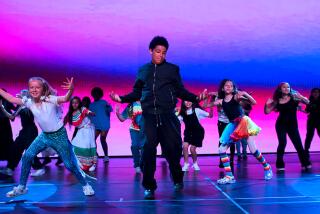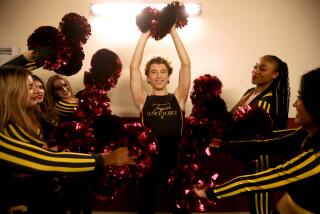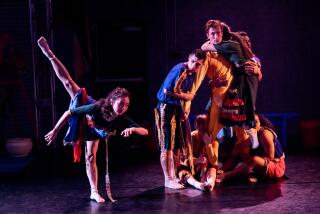ON STAGE AT SDSU : CONCERT WILL FEATURE COSSACK-STYLE DANCES
SAN DIEGO — The ethereal image of a ballerina poised on pointe is one of the most beautiful icons in classical ballet. There is no male equivalent to delicate pointe work anywhere in the dance world. But there is a macho counterpart in the virile, Cossack-style phrases of Soviet Georgian dance.
This exhilarating folk form developed its rugged toe dance vocabulary independent of the influence of classical ballet. The robust folk dances of Georgia put the men up on the tips of their toes, then send them crashing down to earth for a hard landing on their bent knees. The grueling cycle is repeated at lightning speeds.
Although this hearty folk form is still alive and well in Soviet Georgia, dancers in the United States capable of performing these athletic bursts are a dying breed.
Graham Hempel, a member of the dance faculty at San Diego State University, is one of those rare birds. Hempel whetted his appetite for the vigorous dance form as a boy, when he saw “this man who wore funny boots jump up on his toes,” he said in a recent interview on campus.
That experience sparked a lifelong love affair with Georgian dance that has taken him to specialized folk dance camps as far away as Yugoslavia.
This weekend, Hempel will be back in black boots and furry hat. He no longer does the punishing solo work that earned him kudos when he danced with AMAN (the acclaimed Los Angeles-based folk dance troupe) years ago. But he will be flaunting some of the trappings of Georgian dance in a duet called “Kartuli” (which means “Georgian”)--the most popular of the diverse dances in the repertory.
Hempel and the SDSU Folk Dance Ensemble will perform folk dances from Georgia and other parts of the world at 8 p.m. Friday and Saturday at SDSU’s Studio Theatre in the Women’s Gym.
The concert will be a collaborative effort between the SDSU ensemble and two other local folk dance organizations--the Slovak Heritage Dancers and the Royal Scottish Country Dance Society. Hempel is quick to point out that, although his own troupe is associated with the university, it is not just a group of tyros.
The SDSU Folk Dance Ensemble “started out as a class in folk dance, but this is no longer a student group,” Hempel said. “I knew if I wanted to have enough dancers for a performing ensemble, I’d have to open it to the entire community. Now we have many alumni, but we also have folk dancers from all over the area.
“I foresee this (growing into) an ensemble that performs on a regular basis. We’re not seeking any major funding, and we won’t be doing anything large-scale like AMAN. But we’re developing.”
The SDSU Folk Dance Ensemble has a core of 10 dancers, but it will expand to 18 for this concert--still a small company by folk dance standards. And, as Hempel acknowledged, the technical level among the ensemble is uneven. He is, however, working diligently to improve technique among the dancers, and he’s proud of the strides they’ve made.
“There are some very highly trained dancers in the company, and many who have been doing folk dancing for a long time,” he said. “Marilyn Perrin has been studying for many years, and she does Tahini and Polynesian dance with another troupe. Kin Ho (who choreographed three of the pieces on this concert program) is another very good dancer.
“We used to take any man that walked through the door--not every woman, but every man. Now, we’ve upped the ante, and we have much better dancers. In the next few years, San Diego will see quality folk dancing.”
What San Diego audiences can expect to see this weekend is a smorgasbord of international styles--all costumed as authentically as a limited budget will allow.
The opener will be a traditional suite of chain dances from Romania, featuring invigorating couples dancing and fleet-footed maneuvers from both sexes. Hempel’s duet, danced with Donna Beddow, is a Georgian courtship dance that pits the man against the woman in a flurry of flirtatious interplay.
The Slovak Heritage Dancers will show their wares next, followed by an all-musical interlude that signals a new direction for the group.
Ho’s “Ribbon Dance” will give San Diego audiences a glimpse of the traditional Chinese celebration of joy, but Ho has also choreographed a Mongolian herdsman’s dance as a flashy solo for himself.
There are traditional dances of Israel and more.
The finale will feature the hard-driving rhythms and foot-tapping energy of Appalachian clog dance, performed as it was originally conceived--without taps on the shoes.
More to Read
The biggest entertainment stories
Get our big stories about Hollywood, film, television, music, arts, culture and more right in your inbox as soon as they publish.
You may occasionally receive promotional content from the Los Angeles Times.










